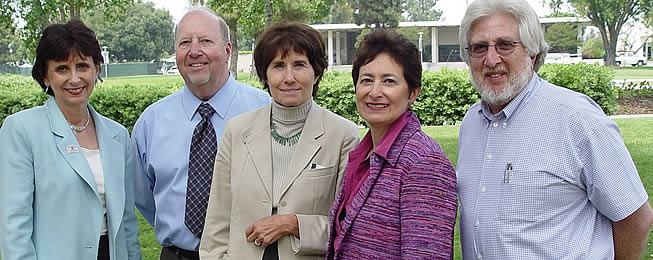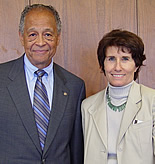| CSUF's Math and Science Teacher Preparation Programs |
|||
|
| Nationwide initiative launched to increase number of qualified educators.
June 7, 2007 :: No. 229 Because of Cal State Fullerton’s innovative programs to increase the number of math and science teachers, the National Association of State Universities and Land-Grant Colleges (NASULGC) is including Fullerton in its analysis of leading university models in teacher education. “We are deeply impressed by Cal State Fullerton and the California State University’s efforts to prepare and induct math and science teachers. We believe there is a lot we can learn from Fullerton that can help other institutions nationwide,” said Howard Gobstein, NASULGC vice president for research and science policy. The Washington, D.C.-based public university association has launched a major, multiyear initiative to “increase significantly the number of high-quality science and mathematics teachers prepared and inducted into teaching.” NASULGC is the country’s oldest higher education association and collaborates with its 215 major state universities, including Cal State Fullerton and the California State University (CSU) system. “It is a real achievement for us that NASULGC, one of the leading national organizations, has selected our teacher preparation programs,” said Cal State Fullerton President Milton A. Gordon. “It is also a real credit to the quality of our programs and the way that our two colleges, the College of Education and the College of Natural Sciences and Mathematics, collaborate to prepare highly qualified math and science teachers.” As part of the association’s efforts, a blue-ribbon commission made up of university leaders, and STEM (science, technology, engineering and math) industry and education experts has been formed to oversee this initiative, Gobstein said. The commission’s work will include analyzing leading models of science and math teacher education, assessing state data on the need for science and math teachers and, especially, working with states and institutions in an attempt to stimulate wider adoption of leading models of math and science teacher education, he added. The commission’s first meeting is June 10. “I’m very proud of our programs and our faculty. It is a distinct honor to be included in NASULGC’s project,” said Claire Cavallaro, dean of Cal State Fullerton’s College of Education. “Cal State Fullerton is ahead of the curve in developing and implementing exemplary programs that prepare quality STEM teachers. We’ve made math and science teacher recruitment and preparation a top campus priority.” As an early part of NASULGC’s project, Sheila Tobias, who has written six books on mathematics and science education, met recently with Cal State Fullerton faculty and administrators instrumental in the university’s STEM teacher preparation programs. Tobias also talked with representatives from the Fullerton School District and the Orange County Department of Education. “It’s an opportunity to explore conversations with the people who are on the ground doing the work to prepare math and science teachers,” Tobias said during her weeklong campus visit. Tobias, who recently served as the outreach coordinator for the Sloan Foundation’s Professional Science Master’s Initiative, said her role with NASULGC is to visit universities “that have good reputations to see what may be worth replicating” on a national level. “Cal State Fullerton is developing outstanding K-12 math and science teachers, and we were able to communicate this to Sheila Tobias and to NASULGC,” said David Fromson, associate dean of the College of Natural Sciences and Mathematics. One of the critical barriers to improving student achievement is a shortage of qualified K-12 math and science teachers — a shortage many fear will worsen, according to NASULGC. Increasing the achievement of high school students is one of the highest national goals to ensure continued competitiveness of the U.S. economy, Gobstein said. “While many higher-education institutions across the nation can and should help achieve this goal, it is particularly important that the NASULGC institutions accept responsibility for helping to meet this challenge,” he said. “Going beyond the production of more STEM teachers, NASULGC institutions should become even more engaged in helping to retain and to develop quality STEM teachers for our nation’s schools.” Cal State Fullerton’s math and science teacher preparation programs are part of the California State University system’s initiative to double its production of math and science teachers from 750 to 1,500 by 2010. The CSU, the state’s major producer of teachers, is on track to meet its objective, having increased the number of credential holders by 38 percent to 1,057 annually. In the 2007-08 governor’s budget, $2 million is earmarked to continue the CSU Math and Science Teacher Initiative and to support a long-term strategy to increase the number of math and science teachers. “Cal State Fullerton's work represents a model of success that is helping to achieve these outcomes,” said Beverly Young, CSU assistant vice chancellor. Chancellor Charles Reed would like successful strategies to be scaled up through replication on other campuses, and the Fullerton programs are excellent candidates for expansion in other locations.” Over the last several years, Cal State Fullerton has embarked on an ambitious effort to increase its production of math and science teachers through its Mathematics and Science Teachers (MAST) project, in which science and math faculty members work together in the training of future teachers, Cavallaro said. The project’s goal is to improve practices in the areas of mathematics and science teacher candidate recruitment, preservice preparation, beginning teacher professional development and retention. As a result, in 2005-06, 46 CSU Fullerton students completed the university’s teacher preparation programs to earn state math credentials, up from 11 in 2002-03 — a 300 percent jump. An important contributor to this increase is CSU Fullerton’s creation of a credential program in Foundational-Level Math (FLM) in 2004. The FLM adviser, Mark Ellis, assistant professor of secondary education, described this program as “reaching out to those with a strong math background and an interest in impacting students in middle grades and early high school, a time when many experience challenges with math as it moves from arithmetic to algebra.” MAST’s success thus far is largely due to the collaborative partnership between the College of Education and the College of Natural Sciences and Mathematics, noted Ephraim P. Smith, vice president for academic affairs. Under Fullerton’s MAST, a wide selection of credential and graduate programs are offered, and solid partnerships have been established with local school districts and community colleges. Outreach and recruitment efforts also are in place to get students interested in considering a career in teaching math and science. Tobias noted that she is impressed with the university’s culture of collaboration among faculty members and administrators within the two colleges, as well as Fullerton’s recruitment strategies to attract students into the teaching profession. “At Cal State Fullerton, this kind of interdisciplinary approach is ingrained in the way our teacher preparation programs are structured and has contributed greatly to our success,” Cavallaro said. For more information, visit http://ed.fullerton.edu/SecED/MAST/ and NASULGC (National Association of State Universities and Land-Grant Colleges) at http://www.nasulgc.org/.
|
|

